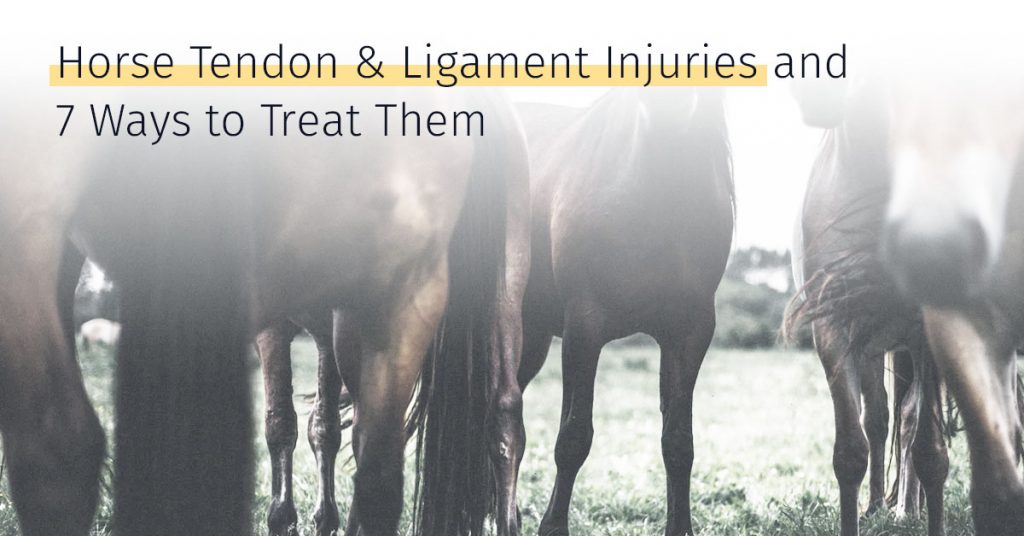
A suspensory ligament injury in horses can limit horses exercise and reduce their quality of life.
So, in this article, you can read all about how to identify and treat a horse’s suspensory ligament injuries in order to prevent unnecessary health problems.
General description
 Ligaments attach bones to each other and act as supports. The suspensory ligament in the horse is a strong, broad, fibrous anatomical structure that attaches to the back of the cannon bone just below the knee — the origin of the ligament.
Ligaments attach bones to each other and act as supports. The suspensory ligament in the horse is a strong, broad, fibrous anatomical structure that attaches to the back of the cannon bone just below the knee — the origin of the ligament.
About two-thirds of the way down the cannon bone, the ligament divides into two branches which attach to the inside and outside sesamoid bones, on the back of the fetlock.
In the upper third of the cannon region, the suspensory ligament lies between the large “heads” of the splint bones. This means it is impossible to feel the ligament, or apply pressure directly to it, so the diagnosis of damage is difficult.
Horse suspensory ligament injuries and their signs
A sprain of the horse suspensory ligament (suspensory desmitis) is usually restricted to one of three areas:
- injury to the upper third of the ligament (called high, or proximal, suspensory desmitis) is common in horses in all disciplines
- injury to the middle third, or body, of the ligament, is easiest to diagnose, but least frequent. National Hunt racehorses and point-to-pointers are most likely to suffer this injury
- damage to the inside or outside a branch of the suspensory ligament is also common, particularly in horses which jump
A suspensory ligament injury in horses causes heat, swelling, and pain
When the middle third, or body, of the suspensory ligament, is sprained the signs are easy to detect as there is often obvious swelling. It usually occurs on both the inside and outside of the leg, contrasting with swelling associated with a tendon strain, which happens to the back of the leg.
Heat is easily felt. The horse will also resent palpation of the injured part of the ligament, the edges of which may be rounded and poorly defined. The ligament may feel softer than normal.
There is usually some lameness, the degree of which often reflects the severity of the injury. However, the lack of lameness does not mean there is no significant injury. With a severe injury, the whole area may be swollen so it can be difficult to assess which part of the ligament is primarily involved.
Cold therapy and bandaging will usually reduce the swelling, making a definitive diagnosis easier. Alternatively, a vet can determine which part is involved and assess the extent of the damage using an ultrasound scanner.
An injury to the inside or outside a branch of the ligament will cause swelling on one side of the fetlock. Do not confuse this with swelling due to direct trauma, such as getting cast.
Lameness associated with a branch injury can be mild to moderate but may improve within days. Again, scanning will confirm the extent and severity of the injury and determine whether there is concurrent damage to either the sesamoid bone or the splint bone on the same side. X-rays may also be needed.
Damage at the top of the suspensory ligament invariably causes lameness — varying from mild to severe — which, if the horse rests, can improve rapidly. The lameness tends to be worst when the horse moves in circles with the affected limb on the outside. Slight localized heat may appear when the lameness is acute, while in subtle cases thermography can detect this. The vein which runs down the inside of the cannon region may be enlarged.
Traditional suspensory ligament injury treatments
In many cases, there is nothing abnormal to feel and the vet will have to use a nerve block to eliminate the lower limb as a source of pain and also determine that the pain is coming from just below the back of the knee.
Scanning is essential, too. Sometimes an obvious black hole in the ligament shows up on the scan; sometimes the changes are more subtle. The ligament may be slightly enlarged, with a tiny disruption of its fibre pattern.

The vet’s aims are to eliminate any predisposing causes such as poor foot balance or inappropriate shoes, to reduce inflammation by the use of cold therapy, laser treatment or therapeutic ultrasound and to encourage good quality repair of the damaged fibers.
Small lesions at the top of the suspensory ligament often resolve with around three months’ box rest, combined with a controlled exercise program. Scanning can be used to monitor healing. Larger injuries in the body or branch may need surgery to remove any blood clots. Prolonged rest combined with an ascending exercise program is an essential part of any treatment regime.
Prognosis depends on many factors including:
- the site of the injury
- the severity of the injury
- the duration of the injury
- the future athletic expectations for the horse
Most horses are able to return to some level of work, but there is also a big chance of reoccurring injury.
With appropriate early treatment most horses with a sprain around the origin of the ligament make a complete recovery; however, the chance of repeat damage to injuries on the body of the ligament is quite high if the horse returns to its former workload. The prognosis for branch injuries is between the other two.
Some factors may predispose the suspensory ligament injury in horses or injury’s recurrence:
- conformation can play a role. A horse with a crooked lower limb will overload one side of the fetlock and predispose it to a branch injury
- poor foot balance is commonly seen in horses that injure the origin of the ligament. If the shoes are too short and offer little support to the back of the heel region, this can cause an overload of the ligament
- fast work: there is also no doubt that suspensory ligament injuries are an occupational hazard for some horses, particularly those which jump at speed
- a previous suspensory injury also places a horse at increased risk of repeat injury since, particularly with body and branch injuries, the repair tissue is never as strong as before
Suspensory Ligament Injury’s Treatment With Stem Cell Therapy
Equine stem cells are adult multipotent stem cells that can differentiate into specialized cells and are able to regenerate tissues such as cartilage, bone, tendon, and muscle.

These cells reduce scar tissue formation. They exert trophic, immunosuppressive, anti-inflammatory and anti-apoptotic effects and activate the body’s own stem cells, modulating the local environment and thereby stimulating tissue regeneration. Once injected into the injury with the help of an ultrasound scanner, they start to work immediately.
Medrego EquiCell Stem Cell therapy has up to 90% high success rate, and the first results in treating suspensory ligament injury in horses can be seen already after first two weeks.
There are also other benefits of Medrego EquiCell stem cell treatment:
- it has a non-invasive procedure in mesenchymal cell obtaining
- Stem Cell Therapy is a simple one injection treatment process
- it reduces scar tissue formation, significantly reducing the chance of getting a repeated injury
- the treatment is ready-to-use at the very moment it is needed
- it improves the mobility of horse, decreasing its lameness
- Stem Cell Therapy decreases inflammation and pain for the horse
- this treatment has a long-term regeneration effect
“Have used Medrego EquiCell stem cell treatment for more than 150 horses and it shows a very good regeneration effect. I will keep using it for sure, as there is no better option.” – says dr. Laizans, FEI Veterinarian.
[mailmunch-form id=”746275″]
Suspensory Ligament Injury Recovery
A suspensory ligament injury in horses is as important as a tendon injury. It needs to be treated the right way.
The torn suspensory ligament can limit or even end your horse’s career in sports. But if you identify it early and treat it the right way, then recovery is possible.
Like tendons, ligaments also heal very slowly because of the weak scar tissue which is in place of the strong stretchy tissue that was damaged.
These are things that you should do to relieve your horse’s suffering:
- Cooldown – Heat and swelling are signs of inflammation which can interfere with the healing process. You need to bring them down. The traditional way to do it is with cold pressure and the old school way – cold hosing or icing and standing wraps. There is a chance that your vet will prescribe the anti-inflammatory drug for your horse.
- Rest – While you are in the cooldown period, your horse should be on full stall rest. Healing can’t start if the torn fibres are constantly moved.
- Walking – After horse’s injury has cooled down, and when your vet has given you green light, you can begin walking your horse but only by hand. If you control the exercises then that will help fibres of the ligament realign in a way that makes them better able to withstand stress and hardness on the leg.
- Rehab – So the next step is again to see if your vet allows you to do this – get your horse back to work. Perhaps one month after walking you can start training him slowly and if he continues to mend, gradually increase the length and intensity of training. Stretch the process out for several months.
- Rechecks – Don’t forget to repeat ultrasound exams at every recovery step. That is the only way to know what is happening inside the leg. This must be done even if you think that everything is okay and your horse can return to his previous daily routine. It is better not to take risks.
All of this recovery will take 6-12 months. It just depends on your horse’s injury.
If you want to get the best solution for treating suspensory ligament injury in horses then contact us.
Medrego EquiCell stem cell therapy has been used to successfully treat hundreds of horses in Germany, Denmark, Norway, UAE, and the Baltic States, and it is ready to help your horse as well. In the meantime – check out our before and after case study.



